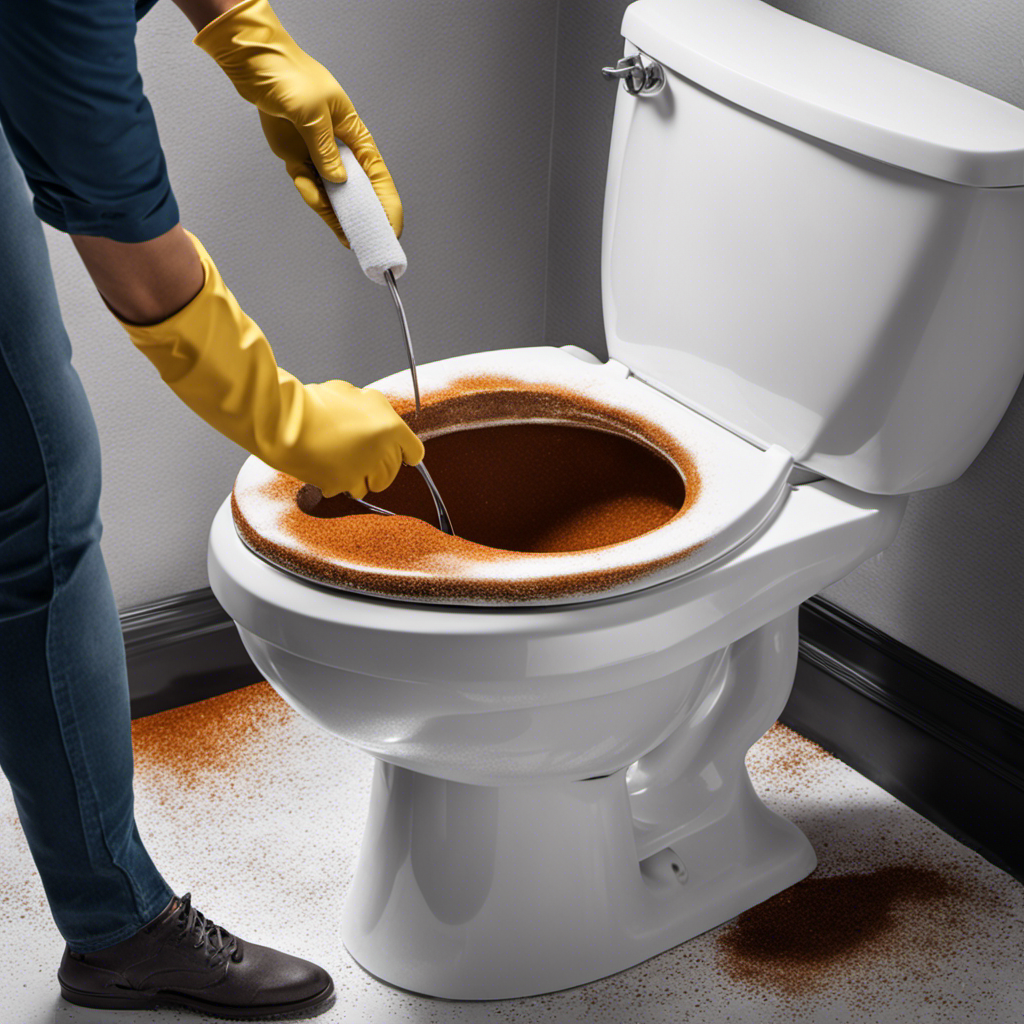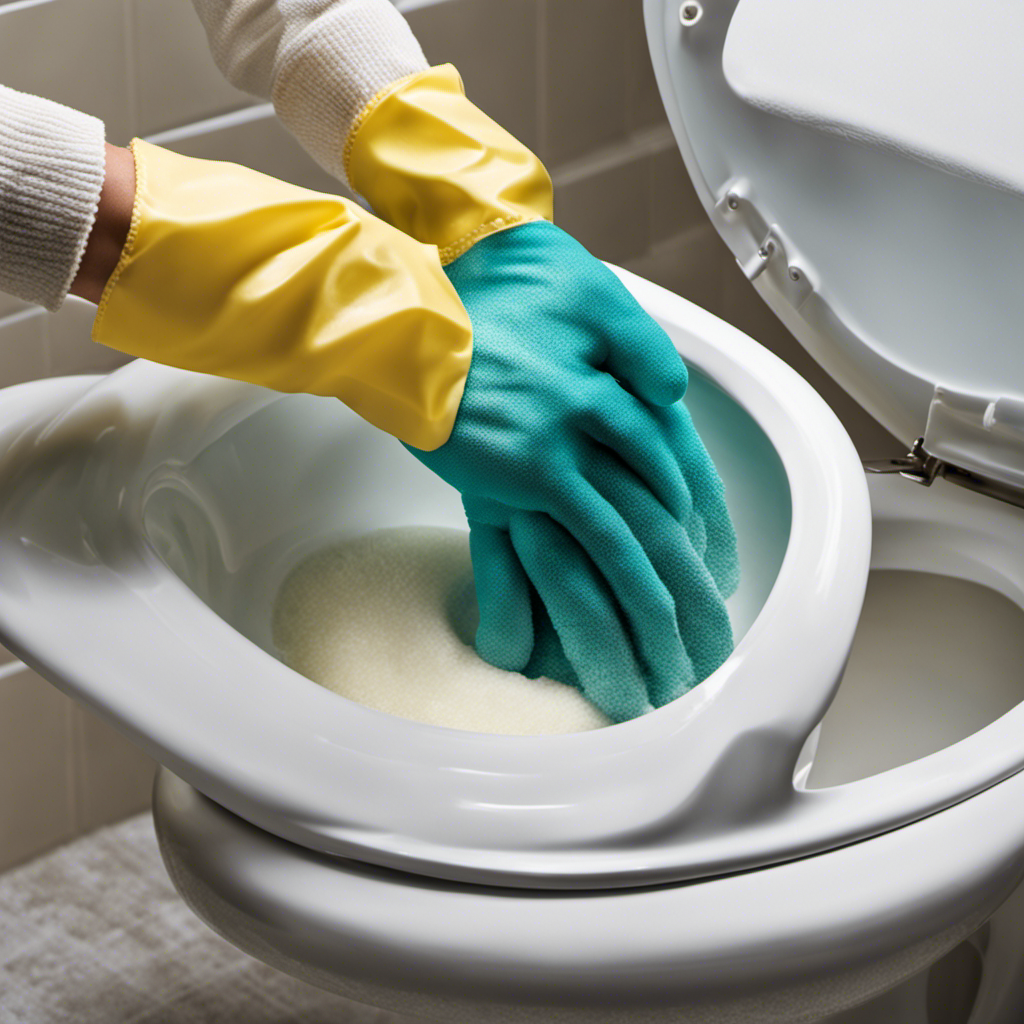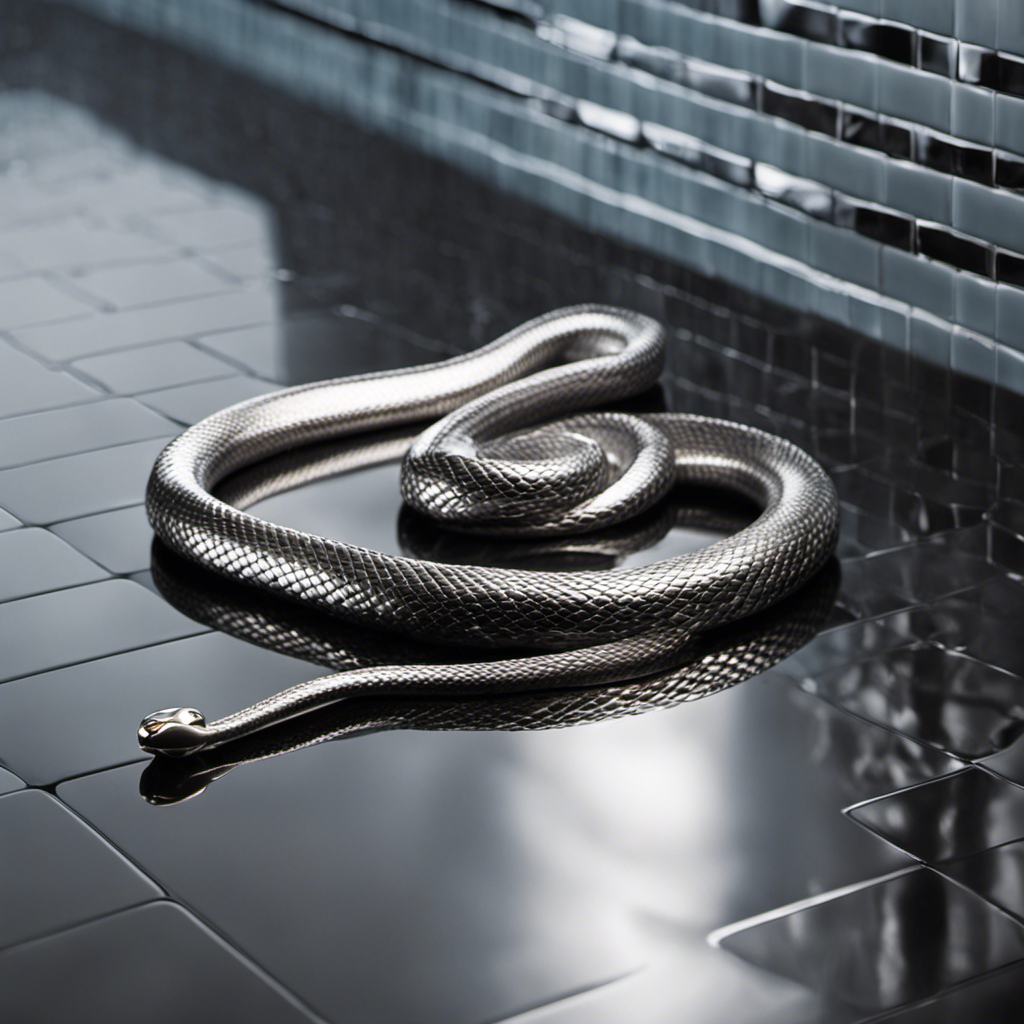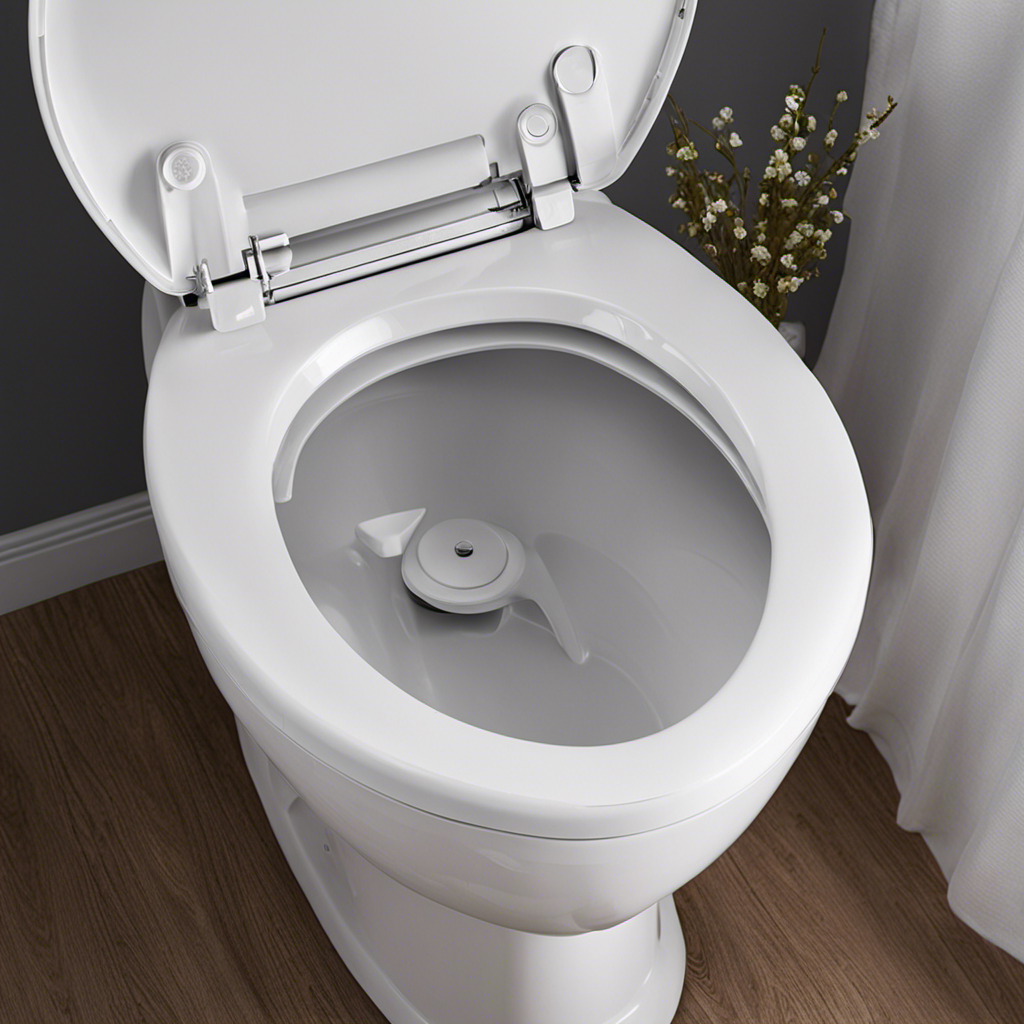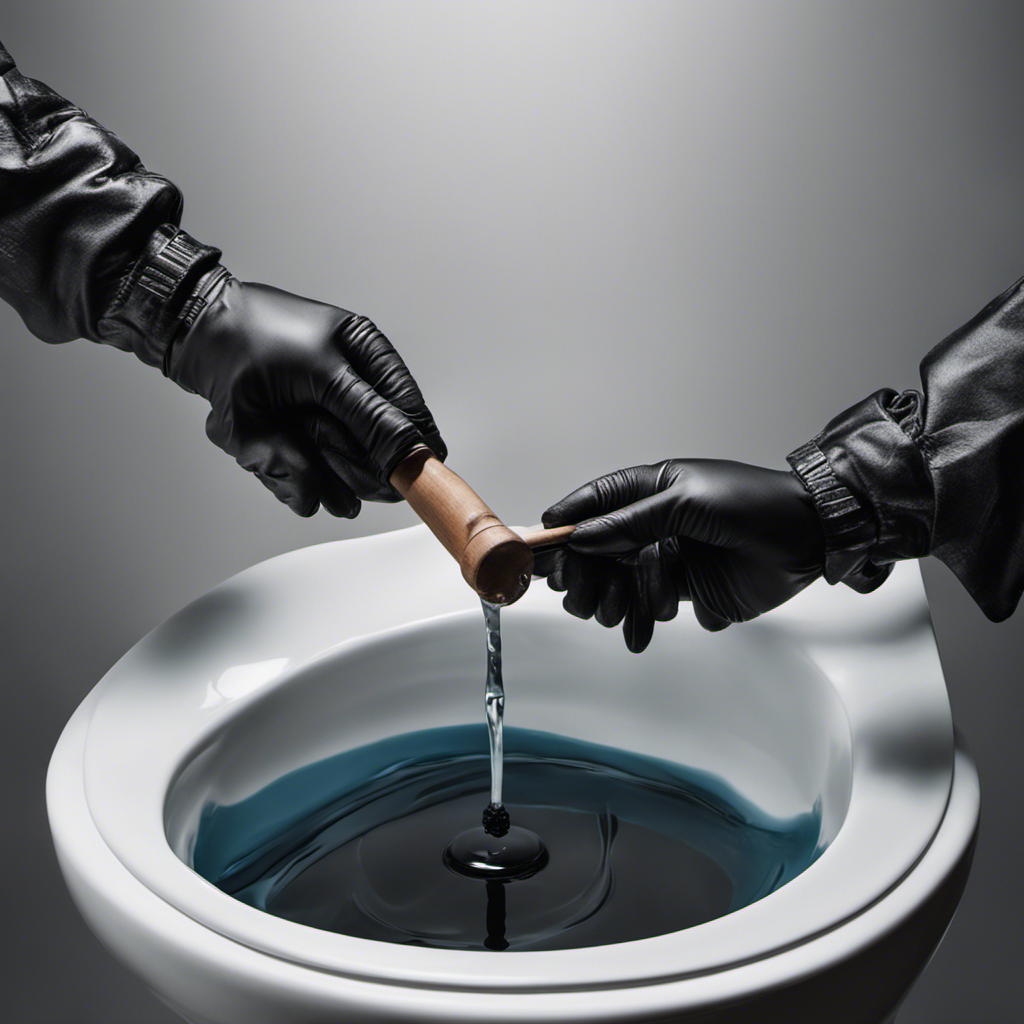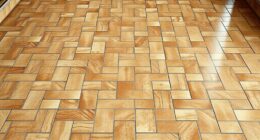Imagine stepping into your bathroom and being greeted by a rusty toilet bowl. It’s an unwelcome sight that can be both frustrating and unsightly.
But fear not! In this article, we’ll guide you through the step-by-step process of how to clean rust in your toilet bowl. With the right supplies and techniques, you’ll be able to restore your toilet to its former glory and say goodbye to those stubborn rust stains.
So, grab your cleaning gloves and let’s get started!
Key Takeaways
- Hard water with high mineral content can react with the metal surface of the toilet bowl, leading to rust formation.
- Installing a water softener can reduce mineral content and prevent rust formation.
- Regularly clean the toilet bowl using a rust stain remover specifically designed for toilets.
- Use natural remedies like vinegar, lemon juice, baking soda, or cola to remove rust stains from the toilet bowl.
Understanding the Causes of Rust in Toilet Bowls
To understand the causes of rust in your toilet bowl, you’ll need to consider factors like hard water and metal pipes.
Hard water contains high levels of minerals like iron and manganese, which can react with the metal surface of your toilet bowl, leading to rust formation.
Additionally, if you have older metal pipes, they may corrode over time and release rust particles into the water supply, which can then accumulate in the toilet bowl.
The effects of rust buildup in your toilet bowl can be unsightly and difficult to remove. It can also lead to the development of stains and pitting on the surface, making it harder to keep your toilet clean.
To prevent rust, you can install a water softener to reduce mineral content, or consider replacing old metal pipes with newer, corrosion-resistant materials.
Gathering the Necessary Cleaning Supplies
Before you begin, make sure you have all the necessary cleaning supplies. Cleaning techniques for removing rust in a toilet bowl require specific tools.
First, you will need a toilet bowl brush with stiff bristles to scrub away the rust. A pumice stone is also useful for tackling stubborn rust stains.
Additionally, you will need white vinegar, which is a natural cleaning agent that helps dissolve rust. To apply the vinegar, a spray bottle is recommended for easy and even distribution.
Finally, you will need a pair of rubber gloves to protect your hands from the cleaning agents and any bacteria present in the toilet bowl.
With these tools in hand, you are ready to tackle the rust in your toilet bowl.
Preparing the Toilet Bowl for Rust Removal
When it comes to removing rust from surfaces, it’s important to know the best methods available.
In this discussion, we will explore the most effective rust removal techniques, providing you with step-by-step instructions on how to get rid of rust once and for all.
Additionally, we will also cover preventive measures to help you avoid future rust buildup, ensuring the longevity of your surfaces.
Best Rust Removal Methods
You can easily remove rust from your toilet bowl using a variety of effective methods. Here are three DIY rust removal techniques using natural rust removers:
-
Vinegar: Pour white vinegar into the toilet bowl, making sure to cover the rusty areas. Let it sit for a few hours or overnight. Scrub the rust stains with a toilet brush and flush. The acidity of vinegar helps dissolve the rust.
-
Baking soda and lemon juice: Make a paste by mixing baking soda and lemon juice. Apply the paste to the rust stains and let it sit for about 30 minutes. Scrub the stains with a toilet brush and flush. The combination of baking soda and lemon juice helps break down the rust.
-
Cola: Pour cola into the toilet bowl, ensuring that the rusty areas are fully submerged. Let it sit for a few hours or overnight. Scrub the rust stains with a toilet brush and flush. The phosphoric acid in cola helps remove rust.
By using these natural rust removers, you can effectively eliminate rust from your toilet bowl.
Now, let’s move on to preventing future rust buildup.
Preventing Future Rust Buildup
To avoid future rust buildup, it’s important to regularly maintain and protect the metal surfaces in your bathroom. This includes the toilet bowl, which is prone to rust due to constant exposure to water and moisture. Regular toilet bowl maintenance is crucial to keep it clean and rust-free. Here are some tips to help you achieve this:
-
Clean the toilet bowl regularly using a toilet cleaner specifically designed to remove rust stains. Scrub the bowl thoroughly, paying attention to areas where rust tends to accumulate.
-
Use a toilet brush with stiff bristles to remove any rust stains or mineral deposits.
-
Consider installing a water softener to reduce the mineral content in your water, which can contribute to rust formation.
-
Avoid using abrasive cleaners or tools that can scratch the surface of the toilet bowl, as this can create a breeding ground for rust.
Using Natural Remedies to Remove Rust
When it comes to using natural remedies to remove rust, you may be wondering about the effectiveness of lemon juice. Well, let me tell you, lemon juice can be quite effective in removing rust stains due to its high acidity.
However, you may also be curious about the comparison between vinegar and baking soda. Don’t worry, I’ve got you covered. Let’s dive into the discussion and explore the pros and cons of using these two popular natural remedies for rust removal.
Lemon Juice Effectiveness
The lemon juice is highly effective in removing rust stains from the toilet bowl. Here’s how you can use it to get rid of those stubborn rust marks:
- Squeeze fresh lemon juice directly onto the rust stains in the toilet bowl.
- Let the lemon juice sit on the stains for about 30 minutes to allow the citric acid to break down the rust.
- Scrub the stains using a toilet brush or a scrub brush until the rust is completely removed.
But what if you don’t have any lemon juice on hand? Don’t worry! There are some effective alternatives you can try:
- Vinegar: Its acetic acid content makes it a great rust remover.
- Baking soda: Create a paste by mixing it with water, then apply it to the rust stains and scrub.
- Coca-Cola: Its phosphoric acid can help dissolve rust.
Remember to always wear gloves when handling any cleaning solution and ventilate the area properly.
Vinegar Vs Baking Soda?
If you don’t have any lemon juice, you can use vinegar or baking soda as alternatives to remove rust stains. Baking soda is a common household item that can effectively clean rust stains. Here’s how you can use baking soda as an alternative to lemon juice:
- Start by dampening the rust stain with water.
- Sprinkle a generous amount of baking soda directly onto the rust stain.
- Using a scrub brush or sponge, gently scrub the baking soda into the stain.
- Let the baking soda sit on the stain for about 10 minutes to allow it to work its magic.
- Rinse the area thoroughly with water and wipe away any residue.
Alternatively, you can also use vinegar as an alternative to lemon juice. Vinegar contains acetic acid, which is effective in breaking down rust stains. Simply soak a cloth or sponge in vinegar and scrub the rust stain until it disappears.
Using Commercial Cleaners to Tackle Stubborn Rust Stains
Using commercial cleaners is an effective way to tackle stubborn rust stains in the toilet bowl. These cleaners are specially formulated to dissolve rust and provide a thorough clean. Here are three reasons why you should consider using commercial cleaners:
-
Powerful Formulas: Commercial cleaners contain strong chemicals that can break down rust and remove stains with ease. They are designed to target rust at its core, ensuring a deep clean and restoring the toilet bowl’s original shine.
-
Time-saving: Compared to homemade remedies, commercial cleaners require minimal effort and time. Simply apply the cleaner to the affected areas, let it sit for a few minutes, and then scrub away the rust stains. It’s a quick and efficient solution.
-
Safety Precautions: When using commercial cleaners, it’s important to follow the safety precautions mentioned on the product label. Wear gloves and ensure proper ventilation in the bathroom. Also, keep the cleaner away from children and pets to avoid any accidents.
Scrubbing Away Rust With Different Cleaning Techniques
You can try different cleaning techniques to scrub away stubborn rust stains.
One effective method is to use natural rust cleaners, which are DIY solutions that can be made at home. To create a natural rust cleaner, mix equal parts lemon juice and salt to form a paste. Apply the paste directly onto the rust stains and let it sit for about 30 minutes. Then, use a scrub brush or sponge to scrub away the rust.
Another option is to use white vinegar, which contains acetic acid that helps dissolve rust. Simply soak a cloth or paper towel in white vinegar and wrap it around the rusted area. Leave it on for a few hours or overnight, then scrub away the rust.
These natural rust cleaners provide an eco-friendly and effective solution for DIY rust removal.
Preventing Future Rust Build-up in the Toilet Bowl
To keep your toilet free from future rust build-up, it’s important to regularly maintain and clean the surfaces. Here are three steps you can take to prevent rust and keep your toilet looking clean and shiny.
-
Use a natural rust prevention method: One way to prevent rust in your toilet is to use a natural rust prevention method. Mix equal parts of lemon juice and baking soda to create a paste. Apply the paste to the rusted areas of your toilet bowl and let it sit for 15 minutes. Then, scrub the area with a toilet brush and flush the toilet.
-
Install a rust prevention device: Another option is to install a rust prevention device in your toilet tank. These devices release a small amount of rust-inhibiting chemicals into the water, preventing rust from forming on the toilet bowl surfaces.
-
Regularly clean and dry the toilet bowl: Lastly, make it a habit to regularly clean and dry your toilet bowl. Use a toilet cleaner specifically designed to remove rust stains and scrub the bowl thoroughly. After cleaning, dry the bowl with a towel to minimize moisture and prevent rust from forming.
Conclusion
In conclusion, cleaning rust from a toilet bowl can be a straightforward process if you follow the right steps and use the appropriate cleaning supplies. By understanding the causes of rust and taking preventive measures, you can keep your toilet bowl clean and rust-free.
For example, let’s consider a hypothetical case where a homeowner neglected rust stains in their toilet bowl for months. After using natural remedies and commercial cleaners, they were able to restore the toilet bowl to its original shine, giving them a sense of satisfaction and relief.
Remember, regular cleaning and maintenance are key to preventing future rust build-up in your toilet bowl.
